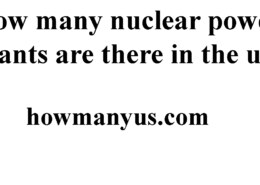How many nuclear power plants are there in the us?
The question “How many nuclear power plants are there in the US?” seeks to understand the number and distribution of nuclear power facilities across the United States. Nuclear power plants are critical components of the nation’s energy infrastructure, generating electricity through nuclear reactions to heat water and produce steam that drives turbines.
How many nuclear power plants are there in the us?
Context and Significance:
Nuclear power plays a significant role in the US energy landscape due to its capacity for producing large amounts of electricity with minimal greenhouse gas emissions. Understanding the number of nuclear power plants in the US is essential for various reasons:
- Energy Production: Nuclear power plants contribute a substantial portion of the country’s electricity supply, especially in states heavily reliant on nuclear energy.
- Carbon Emissions Reduction: Nuclear power is considered a low-carbon energy source, helping the US meet its climate goals.
- National Security: Nuclear power plants require stringent safety and security measures due to the potential risks associated with nuclear materials.
- Economic Impact: Nuclear power plants create jobs and support local economies in areas where they are located.
Knowing the number and locations of nuclear power plants informs energy policy decisions, emergency preparedness strategies, and environmental considerations.


The United States operates a significant number of nuclear power plants, providing a substantial portion of the nation’s electricity. As of the latest data available, there are approximately 93 commercial nuclear reactors operating across 28 states in the US. These reactors are housed within 56 nuclear power plants.
Distribution of Nuclear Power Plants:
Key Facts about US Nuclear Power Plants:
Benefits of Nuclear Power:
Challenges and Considerations:
In summary, the US operates a significant number of nuclear power plants spread across various states, contributing to the nation’s energy needs and serving as a crucial component of the electricity grid.